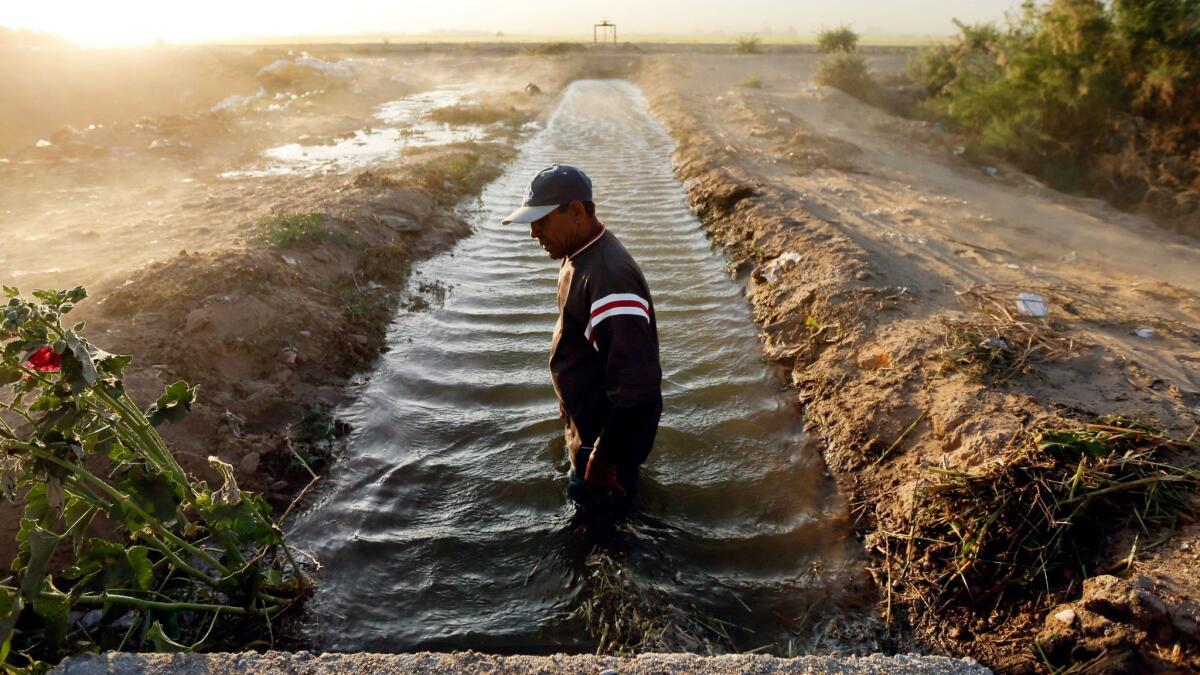U.S. and Mexico may be at odds, but they’ve reached agreement on managing the Colorado River

- Share via
Reporting from Las Vegas — The United States and Mexico expanded a long-term agreement Wednesday that will allow both nations to continue using the Colorado River while also pushing more conservation efforts to ensure that water is available during droughts.
The nine-year deal, which expands on a 1944 water treaty between the two countries, would see the United States spend $31.5 million on conservation efforts in Mexico, according to water agencies that are familiar with the plan. That effort would, in turn, generate access to more water for about 27 million people in several states, including California, Nevada and Arizona.
It would also guarantee that Mexico and the United States would shoulder water supply cutbacks in the event of low water levels in the Colorado River and Lake Mead during droughts.
The signing of the agreement in Santa Fe, N.M., was led by the International Boundary and Water Commission. The agency is responsible for overseeing water treaties between the United States and Mexico and is composed of representatives from both countries.
Officials with the IBWC would not release details of the agreement before the signing Wednesday.
Several water agencies in California, Nevada and Arizona have anticipated the agreement for weeks and were optimistic the conservation efforts aimed at Mexico would ultimately lead to more secure water supplies for residents and farmers who rely on Lake Mead and the Colorado River.
Some of the conservation efforts in Mexico funded by the United States would include relining leaky canals, improving water pump systems and using more advanced runoff capture systems that allow water to be reclaimed and stored, according to officials familiar with the agreement.
Southern Nevada Water Authority General Manager John Entsminger, who attended the signing in New Mexico, said in a statement that the agreement was critical for long-term sustainability.
“The Colorado River basin drought continues to be a serious issue, and this agreement shows how the seven states, the country of Mexico and our federal government are taking proactive steps to collaboratively address the situation and reduce the potential for shortages,” Entsminger said. “For Southern Nevada, we gain more tools to protect our community’s water supply, and Mexico gets both a valuable water reserve and increased flexibility in managing their water resources.”
Entsminger’s agency, which sells water wholesale to districts that provide for 2.2 million people primarily in the Las Vegas area, moved in August to support the goals of the agreement.
The Colorado River, which feeds into Lake Mead, stretches about 1,400 miles — beginning in the Rockies and reaching its end in the Gulf of California. Within the United States, it is the source of water for about 40 million people.
The treaty grants Mexico 1.5 million acre-feet among the river’s annual flow of 14.8 million acre-feet, according to the Department of the Interior. Seven states — Utah, Wyoming, Colorado, New Mexico, Arizona, Nevada and California — are in the river basin and use the rest of water.
Mexican IBWC Commissioner Roberto Salmon said the agreement gives his country better flexibility and stability amid the challenges brought about by future water shortages.
“This agreement provides certainty for water operations in both countries and mainly establishes a planning tool that allows Mexico to define the most suitable actions for managing its Colorado River waters allotted by the 1944 Water Treaty,” he said in a statement.
Access to the Colorado River has been a critical issue since the latest drought gripped the Southwest. According to the nonprofit environmental group American Rivers, the Colorado River could see its flow reduced by 10% to 30% by 2050 because of the effects of climate change.
Lake Mead has seen its water levels drop dramatically since 2002, when it was at 1,152 feet above elevation. This year, it stood just above 1,080 feet.
If Lake Mead hits 1,075 feet — a critical low — Nevada, Arizona and Mexico will have to reduce the amount of water they can take from the Colorado River.
Jeffrey Kightlinger, general manager of the Metropolitan Water District of Southern California, said that the river is already close to a critical shortage and that the agreement helps all parties navigate the effects of climate change on the river’s future.
“The drought has been the catalyst for forcing us to deal with the issues,” Kightlinger said. “Climate change is real and it’s definitely going to be painful, and we have to get the tools in place to manage it now.”
Twitter: @davemontero
More to Read
Sign up for Essential California
The most important California stories and recommendations in your inbox every morning.
You may occasionally receive promotional content from the Los Angeles Times.













